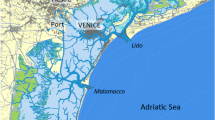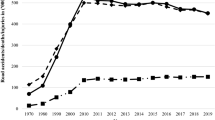Abstract
In concert with developments in global trade and energy resource transportation, there has been a marked increase in reliance on overseas shipping. Unimpeded marine transportation has therefore become a key issue which influences national maritime interests including the security of trade and energy resources. A strategic shipping pivot thus performs a vital controlling function for global shipping networks. In this study strategic shipping pivots are defined and subdivided into sea hubs, channels and areas. We then develop a model to identify strategic shipping pivots on a global scale. The results show that, depending on differences in location, function, and type, the concept of strategic shipping pivot permits the identification of both spatial and structural differentiation with respect to strategic hubs, corridors, and seas. Now 44 strategic hubs have formed across the globe. These hubs have become the control centers of local shipping network organization. At the same time, seven strategic corridors containing most shipping routes and transportation capacity connect important sea areas, and permit a high-degree of control over the transport of strategic materials. The strategic seas, the Caribbean, the Mediterranean, Southeast Asia, and the Pacific provide vital import and export pathways, so that the formation of strategic shipping pivots is mainly influenced by factors such as physical geographical conditions, the spatial distribution of socio-economic activities, business organization, technical progress, geopolitical patterns and geopolitical disputes. Physical geographical conditions provide the potential foundations for strategic shipping pivots, while the spatial distribution of socio-economic activities and communications determine the strategic value of these points. Finally, business organization, technical progress, and geopolitical disputes all function to strengthen the strategic mechanisms and the mutagenicity of strategic shipping pivots.
Similar content being viewed by others
References
An X P, Han Z L et al., 2000. A study on the formation, evolvement mechanism and development mode of international container load center. Geographical Research, 19(4): 383–390. (in Chinese)
Baird A J, 2005. Optimising the container transhipment hub location in northern Europe. Journal of Transport Geography, 14(3): 195–214.
Bennett M M, 2016. The Silk Road goes north: Russia’s role within China’s Belt and Road Initiative. Area Development and Policy, 1(3): 341–351.
Bradford J F, 2005. The growing prospects for maritime security cooperation in Southeast Asia. Naval War College Newport Review, 58(2): 63–86.
Cai M J, 2008. The impact of Panama Canal expansion on world shipping. China Maritime, ((2): 69–71. (in Chinese)
Chen J Y, 2007. Study on the safety assessment of navigation circumstance. Research on Waterborne Transportation, 3(1): 27–32. (in Chinese)
Chen W L, He C T, 2014. Game of all parties and its economic and trade orientation for Maritime Silk Road. Reform, ((3): 74–83. (in Chinese)
Chen X Q, Guan X O, 2017. The past and present of earth’s energy neck vessel the Suez Canal. Energy, ((9): 90–93. (in Chinese)
Cullinane K, Khanna M, 2000. Economies of scale in large containerships: Optimal size and geographical implications. Journal of Transport Geography, 8(3): 181–195.
Du J, Qiu H, Hu H X, 2014. The safety of the sea lane: An analysis and thinking based on national benefit relativity. Journal of Nanchang University, 45(3): 62–67. (in Chinese)
Fraser D, Notteboom T, 2014. A strategic appraisal of the attractiveness of seaport-based transport corridors: The Southern African case. Journal of Transport Geography, 36: 53–68.
Green M J, Shearer A, 2012. Defining US Indian Ocean strategy. The Washington Quarterly, 35(2): 175–189.
Guo W B, 1982. The west gate of the Mediterranean: The Strait of Gibraltar. West Asia and Africa, ((6): 67–69. (in Chinese)
Hou L M, 2015. Context, position and realization path of Maritime Silk Road in 21st century. Journals of Huaihai Institute of Technology, 13(6): 14–16. (in Chinese)
Hudson R, 2016. Rising powers and the drivers of uneven global development. Area Development and Policy, 1(3): 279–294.
Jia D S, Sun J Y, Luo H B, 2006. Chinese importing oil marine lane safety evaluation and strategy. Journal of Dalian Maritime University, 32(2): 62–66. (in Chinese)
Li B, 2010. A discussion on the status and action of maritime strategy passage. Contemporary World & Socialism, ((2): 90–94. (in Chinese)
Li J, 2010. Overview of world maritime strategy. Decision & Information, ((11): 73–76. (in Chinese)
Li Z, 2010. Impact of the Panama Canal expansion on the bulk shipping market. China Water Transport, ((10): 13–13. (in Chinese)
Liang M, Chen R D, 2014. Study on situation and strategy of maritime trade passage. International Economic Cooperation, ((11): 79–84. (in Chinese)
Liang J R, 2016. Ocean strategy of the South-Pacific region from the perspective of Maritime Strategy Passages. Forum of World Economics & Politics, ((3): 47–60. (in Chinese)
Liao X N, Li Y H, 2013. The strait of Malacca under the contention between great powers. The World & Chongqing, ((3): 15–16. (in Chinese)
Liu W, Dunford M, 2016. Inclusive globalization: Unpacking China’s belt and road initiative. Area Development and Policy, 1(3): 323–340.
Notteboom T E, 2006. Traffic inequality in seaport systems revisited. Journal of Transport Geography, 14(2): 95–108.
Quan Y, Wang J, Liu W T, 2014. Strategic conception and construction general plan for Maritime Silk Road in 21st century. Intertrade, ((8): 4–15. (in Chinese)
Ren J J, 2008. Game between America and Iran for the Strait of Hormuz. Leadership Science, ((21): 55–56. (in Chinese)
Sun H Y, 2014. The Kra Channel and sea routes: Challenges, meaning, and China’s strategic choice. Pacific Journal, 22(7): 90–100. (in Chinese)
Shen Y H, 2002. The last colony: Gibraltar. International Study Reference, ((2): 33–36. (in Chinese)
Shi C L, Li X Y, 2013. The impact of the security of the Strait of Hormuz on China’s imported oil supply and shipping. China Soft Science, ((7): 1–15. (in Chinese)
Shi C L, Li X Y, 2014. The Suez Canal and shipping safety–and China’s navigation policy. Pacific Journal, 22(10): 79–90. (in Chinese)
Su X, 2016. Repositioning Yunnan: Security and China’s geoeconomic engagement with Myanmar. Area Development and Policy, 1(2): 178–194.
Sun F H, Liu Y J, 2002. “Oceanic Broken Area” in the 21st century. Human Geography, 17(6): 71–76. (in Chinese)
Slack B, 1990. Intermodal transportation in North America and the development of inland load centers. The Professional Geographer, 42(1): 72–83.
Song D W, 2002. Regional container port competition and co-operation: The case of Hong Kong and South China. Journal of Transport Geography, 10(2): 99–110.
United States Department of Defense. The Asia-Pacific Maritime Security Strategy, July 2015 [EB/OL]. http//www.defenselink.mil/
Veenstra A.W, Mulder H.M, Sels R.A, 2005. Analysing container flows in the Caribbean. Journal of Transport Geography, 13(4): 295–305.
Wang C J, 2008. Spatial organization networks of world marine container transportation. Geographical Research, 27(3): 636–648. (in Chinese)
Wang H, 2007. From the Beibu Gulf to the Indochina Peninsula and the Indian Ocean: Building a China-ASEAN strategic passage which serves to avert a “Malacca Dilemma”. World Economics and Politics, ((9): 47–54, 4. (in Chinese)
Wang L R, 2015. Maritime strategy passage impact on China’s economic security and countermeasures. Journal of Economics of Shanghai School, 13(1): 146–156. (in Chinese)
Wang N, 2005. A study of the Suez Canal’s security defense issue from the second half of 19th century to early 20th century. Journal of Luoyang Normal University, 24(4): 89–93. (in Chinese)
Wang N, 2006. Superpowers’ game for the Strait of Malacca. Leaders’ Companion, (2): 20. (in Chinese)
Xin H, 2003. “Shattered Area”: The geographical pivot of contemporary international relation. World Regional Studies, 12(1): 100–106. (in Chinese)
Yang H S, 2006. Brief analysis of the Kra Channel’s impact on national energy security and development. Pearl River Water Transport, (Suppl.1): 183–184. (in Chinese)
Zhang G G, 2013. The draw lessons from Gibraltar disputation between Britain and Spain. South Reviews, ((24): 76–77. (in Chinese)
Zhang J, 2015. Sea-lane security and construction of China’s strategic pivots–and security consideration for construction of Maritime Silk Road in 21st century. Journal of University of International Relations, 33(2): 100–118, 159–160. (in Chinese)
Zhao F, Lou X C, 1998. Gullet of the marine passages: Strait. Hydrographic Surveying and Charting, ((1): 40–47. (in Chinese)
Zheng Z Y, Zhang J Z, Dong W F et al., 2012. Deployment of China’s strategy passages at sea. Navigation of China, 35(2): 55–59. (in Chinese)
Zhu L S, 1982. The Panama Canal negotiation and new treaty between Panama and America. World History, ((4): 54–62. (in Chinese)
Author information
Authors and Affiliations
Corresponding author
Additional information
Foundation: The Strategic Priority Research Program of the CAS, No.XDA20010101; National Natural Science Foundation of China, No.41571113; The Key Project of the Chinese Academy of Sciences, No.ZDRW-ZS-2017-4
Rights and permissions
About this article
Cite this article
Wang, C., Chen, P. & Chen, Y. The identification of global strategic shipping pivots and their spatial patterns. J. Geogr. Sci. 28, 1215–1232 (2018). https://doi.org/10.1007/s11442-018-1521-x
Received:
Accepted:
Published:
Issue Date:
DOI: https://doi.org/10.1007/s11442-018-1521-x




